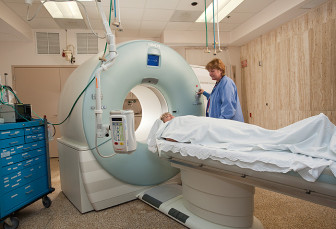UConn’s John Dempsey Hospital has drastically reduced the frequency of “combination” CT scans of patients’ chests and abdomens, as federal regulators have clamped down on the practice, which carries a risk of excess radiation.
New data provided by Dr. Douglas Fellows, chair of radiology at the UConn Health Center, shows that the hospital has reduced the rate of double scans of the chest to below 1 percent, and the rate of combination abdominal scans to 23 percent for Medicare patients, the population that federal regulators track.

CT Scan” credit=”
A 2011 story by C-HIT disclosed that Dempsey’s double-scan rate was the highest in the state and far exceeded the national average, with 48 percent of all patients who received chest scans subjected to combination scans—nearly 10 times the national average—and more than 72 percent who received abdominal scans getting double procedures. That data was from 2008.
Fellows said the hospital has made a concerted effort in the last two years to crack down on double scans, by educating emergency department personnel, physicians in other parts of the hospital, and community doctors who order the scans.
“It isn’t that they were doing anything for the wrong reasons — it’s just that they were trained years ago” to perform double-scans to make certain diagnoses, Fellows said. “It’s been a matter of re-educating them.”
Combination CT scans mean that a patient gets two scans – one regular scan, and a second with a substance called “contrast” that is put into the patient’s body before the scan begins, to help make parts of the body stand out more clearly on the x-rays.
Nationally, when a patient shows up at a hospital for medical imaging for a chest or abdominal malady, the chances that he or she will get a combination CT scan are slim: 4 percent in the case of chest scans, and 14.9 percent for abdominal scans, according to the most recent data compiled by the U.S. Centers for Medicare & Medicaid Services (CMS).
Combination scans have come under scrutiny because they may unnecessarily expose patients to excess radiation. Standards of care say that most patients who get a CT scan of the chest should be given a single scan, rather than a double study. “Combination scans are usually not appropriate for the chest,” CMS guidelines say.
Similarly, with abdominal scans, a rate of double scans that is higher than the national average may indicate that “too many patients are being given a double scan when a single scan is all they need,” CMS says.
For chest scans, a patient’s radiation exposure from a double scan is 700 times higher than from a simple chest X-ray. For combination abdominal scans, the radiation exposure is 22 times higher than for an x-ray of the abdomen.
Fellows said that Dempsey has changed request forms for scans to add guidance on when scans with contrast, versus those without, should be used. He said that for kidney stones, for example, one non-contrast scan is usually adequate. But he added, “there will always be a small number of cases” where double scans are necessary.
Overall, the state’s average for double scans – 2 percent for chest scans and 9 percent for abdominal scans – is lower than the national average. A number of hospitals, including Middlesex, Yale-New Haven and Danbury – are well-below the national average.
Double scans are more expensive than single scans – nearly 60 percent higher in cost, according to average Medicare reimbursement rates. While CT scans are a steady revenue source for hospitals, a number of recent studies have pointed to potential risks from radiation exposure.
Two reports in the Archives of Internal Medicine found that doses of radiation from the commonly performed procedure vary widely and may contribute to tens of thousands of future cancer cases. One study published in the journal Radiology found that emergency department use of CT scans had increased nearly six-fold since 1995 and showed no signs of tapering off. Another study published last year in the journal Pediatrics showed CT scans in children with abdominal pain rose from less than one percent in 1998 to more than 15 percent in 2008.
The American College of Radiology [ACR], with more than 30,000 members, has expressed concerns about the unnecessary use of scans, saying that “no imaging exam should be performed unless there is a clear medical benefit that outweighs any associated risk.”